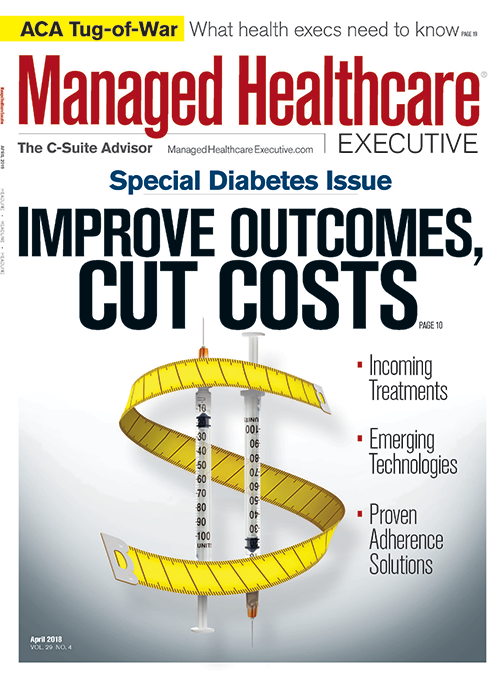3 New Approaches to Provide Individualized Diabetes Care
Diabetes is one of the nation’s costliest public health emergencies. Here are three fresh approaches that can make a difference.

For all the progress science and medicine have made over the last century in treating diabetes-particularly adult-onset diabetes-we haven’t done a very good job of preventing it.
Unlike cancer, which has seen declining incidence rates in the U.S. since the early 1990s, diagnosed diabetes rates have doubled over the last 20 years. On the current pace, 40% of Americans will be living with diabetes or prediabetes within the next few years, and diabetes-related spending and lost productivity will cost the country $500 billion annually within the next decade.
It is one of the nation’s costliest public health emergencies-and it will remain so, unless we make a coordinated effort to bend the curve. I talk to clinicians and subject-matter experts about diabetes care often, and have come to understand there are a few ways we should approach this:
1. Team-based care
Historically, patients living with chronic conditions like diabetes might have seen their primary care physician three or four times a year. Apart from those visits, they were on their own when it came to managing their disease.
We can’t allow that to happen anymore. It takes a multidisciplinary team to address diabetes symptoms, especially when it comes to patients with records of poor treatment adherence. That means PCPs, endocrinologists, pharmacists, social workers, diabetes educators, and behavioral health specialists have to be on the same page when it comes to creating individualized treatment plans and identifying the barriers to care that exist for so many patients living with diabetes.
Of course, if providers and insurers are focused solely on disease management, we’ve already lost the battle. We have a lot of analytical tools at our disposal, and we need to better utilize them in order to identify those living with prediabetes conditions, allowing our care teams to intervene before it becomes a chronic disease.
2. Healthy eating
Emerging research confirms what we’ve pretty much known all along-the key to preventing and mitigating type 2 diabetes is tied to what we eat.
As providers, we have to acknowledge that what we’ve done for the last 30 years-actively prescribing medicines and passively monitoring a patient’s diet-has not been terribly effective. That means embracing a more nutrition-centric treatment model and taking a more active role in dietary control. Some providers have even opened fresh food “farmacies” where dieticians, in consultation with physicians, can “prescribe” several days’ worth of free fruits, vegetables, and high-protein foods to type 2 diabetes patients who are also food insecure.
Related article: The Benefits of a Team-Based Approach in Disease Management
For many patients, medication is a simpler fix than lifestyle modification-even if those medications are extremely costly. But it’s our job to help patients and their families understand that eating well allows them to live well, too. It’s hard work for all stakeholders, but the health benefits are evident.
3. Embracing new tools
Many patients living with diabetes are very good about monitoring their blood sugar levels and responding accordingly. Others need more hands-on care.
Fortunately, there are a number of new technologies that help patients manage their diabetes and more easily understand their glucose readings. These Internet-connected technologies also present clinicians, researchers, insurers, and others a great opportunity to collect and share diabetes data, with an end goal of providing predictive, real-time care to patients living with the disease. And smartphones, growing more ubiquitous each year, have the potential to become the standard platform for remote monitoring, education, and clinician consultation.
That potential is exciting for those of us in healthcare, but the race to make sense of these rich streams of data may be confusing in the short term. Providers, insurers, and device manufacturers will have to work together to ensure that these new technologies are cost-effective and tied to appropriate reimbursement schedules.
But if we can sort through those issues-and I believe that we will-we have a remarkable opportunity to avert new diabetes cases, and to improve the lives of millions of existing diabetes patients with more responsive, more convenient, more affordable care.
Cynthia Hundorfean, a Managed Healthcare Executive editorial advisor, is president and CEO of Allegheny Health Network (AHN), an integrated healthcare delivery system that serves Western Pennsylvania. AHN is part of the Highmark Health family of companies.

In the Scope of Virtual Health and the Future of “Website” Manner, Per Ateev Mehrotra
August 10th 2023Briana Contreras, an editor of Managed Healthcare Executive, had the pleasure of catching up with MHE Editorial Advisory Board Member, Ateev Mehrotra, MD, MPH, who is a professor of healthcare policy at Harvard Medical School and an Associate Professor of Medicine and Hospitalist at Beth Israel Deaconess Medical Center.
Listen